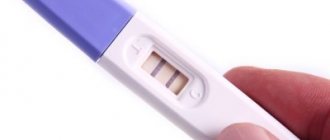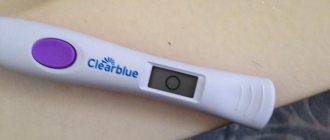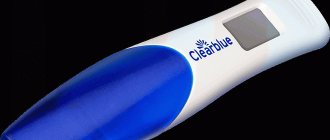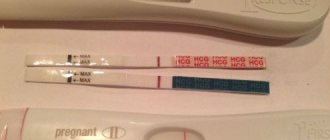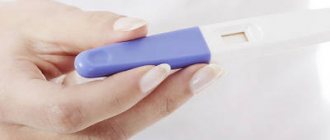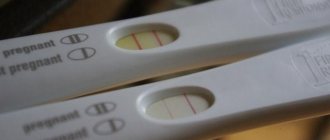Can an ovulation test show pregnancy: what women should pay attention to!
For any representative of the fairer sex, hormonal levels are constantly changing.
How accurately hormone levels will be determined will be determined by both the menstrual cycle and how well the tests were performed. If in the case of the first factor nothing depends on you, then with the second everything is simpler. Modern technologies make it possible to carry out many necessary tests right at home. So, in addition to the well-known pregnancy detection strips, there are also ovulation tests , which can determine how the egg develops and identify the time that will be most correct for conception.
But it should be noted that many are interested in the question of what such a test will demonstrate if a woman is pregnant. This needs to be looked into in more detail.
False indicators
Before you say whether an ovulation test can show pregnancy, you should warn that this is in any case the result of an imperfect diagnostic system, which means that such indicators cannot be trusted. If you are pregnant, the test result, once positive, will not turn negative. If this happens, you should immediately tell your doctor about it.
In this case, an ovulation test can show pregnancy, but only because human chorionic gonadotropin and luteinizing hormone have similar formulas, and the test is not only highly sensitive, but also has a fairly large error.
Can an ovulation test show pregnancy?
If the latter meets the sperm, then conception occurs. If everything is normal in a woman’s body, she can feel ovulation approaching. At this time, as a rule, sexual desire increases (as intended by nature for procreation).
Mild pain in the ovaries is also possible. All this indicates the arrival of the right moment. To track ovulation, women who want to become pregnant can use tests that show its approach .
Ovulation tests are a fairly significant moment in identifying the right moment for conception. Many ladies who cannot get pregnant for a long period actively buy such tests, monitoring the moment of egg release every day. These products work on a fairly simple principle. The strip determines the level of luteinizing hormone LH . Before the follicle ruptures, the level of this hormone becomes maximum.
When you notice two noticeable lines, you know that ovulation will occur in approximately 12 to 48 hours. But we must not forget that failures are possible with any home diagnostic tools. The test strip should be similar in brightness to the control strip. Otherwise, the reliability of the result can be doubted. Many pregnant women have heard that you can see confirmation of pregnancy on an ovulation test. Is this true?
Any tests for home use have a significantly lower level of accuracy than tests performed in a laboratory. Therefore, it may be that the ovulation test will show as pregnancy, and vice versa. Both of these conditions are determined by the level of the hormone in the urine. These hormones are different, but tests that are simple in nature may well confuse them. An active increase in the concentration of a substance, as during ovulation, and after the fact of conception, looks identical . Therefore, in theory, an ovulation test can show conception, but you definitely shouldn’t trust what you see one hundred percent.
In theory, an ovulation test detects only eggs that are mature and ready to be released. Clearly this is not possible if the woman is pregnant, but the belief that an ovulation test can be used to diagnose pregnancy is quite common. Moreover, it is believed that it shows faster results than a test designed specifically for pregnancy.
Sometimes a woman herself can confuse the test and mistakenly buy something that is not what she needs. Many girls who are pregnant have seen a positive result on an ovulation test. Others carried out such diagnostics for an experiment, already knowing that they were pregnant. And for many, pregnancy actually showed.
However, given all this, you need to understand that a positive result of an ovulation test in a pregnant woman is only a consequence of its imperfect design, so you should not trust it.
- A test that becomes positive in a pregnant woman cannot become negative. If this happens, you should inform your doctor. An ovulation test is sometimes able to demonstrate that conception has occurred only because the luteinizing hormone has a certain similarity with hCG in terms of the structure and formula they have. And the test, along with a high level of sensitivity, also has a considerable error rate .
- A pregnancy test and an ovulation test are not interchangeable ! Any doctor will tell you that an ovulation test is less sensitive than a pregnancy test, so you can argue with its results. To gain confidence, wait for the delay. Therefore, a pregnancy test is not used to detect the time of ovulation, since it cannot respond to an increase in lutein, which is not as strong as a surge in hCG.
But an ovulation test does sometimes show two lines in a woman who is pregnant, much earlier than a pregnancy test , until the moment of delay. And many women trust this diagnostic method, considering it quite accurate, and using it even earlier than the earliest pregnancy test. It should be noted that the use of such a test to determine the fact of conception is not very economically feasible: an ovulation test costs significantly more than all tests to detect pregnancy.
As we understand, you can see the result on this test, but its accuracy remains open. So is it possible to be sure of the veracity of the result obtained? No, it’s impossible, because a special strip is intended for a different purpose, so it simply cannot one hundred percent accurately diagnose something that is not within its competence.
Operating principle
In order to understand the question of whether an ovulation test can react to pregnancy, it is necessary to study the principle of its operation. Its direct purpose is to identify the moment when maximum fertility begins in the female body.
It works in almost the same way as pregnancy tests, with one difference - the cassette and strip reagents respond to luteinizing hormone or LH, and not to the hCG hormone produced by the body of a pregnant woman.
The presence of LH in the body correlates with the phase of the menstrual cycle. When a new cycle begins, the follicle matures in the ovaries, and its cells produce estrogens. As the follicle enlarges, more estrogen ends up in the bloodstream. Once there is enough estrogen for ovulation to occur, LH production begins. If you do an ovulation test at this time, it will show 2 stripes, which means it will be positive. During the test, late ovulation may be confused with pregnancy.
Subsequently, over the course of 2 days, the follicle bursts and releases a cell prepared for fertilization in the fallopian tube. This is ovulation, when the likelihood of getting pregnant increases as much as possible.
Sometimes women use such tests to prevent unwanted conception because they help them understand when to abstain from sex.
Is it possible to see pregnancy on an ovulation test before the delay?
You should not treat an ovulation test as a method of diagnosing pregnancy, either before or after a delay. The accuracy of this method is zero, and two strips obtained in the early stages are simply an error.
And after a period of more than four weeks, the test cannot show results at all. However, women who feel good about their body can do without tests at all. They already feel both approaching ovulation and pregnancy. In case of various malfunctions in the body, you should rely not on tests, but on the help of medical professionals.
No matter what people say, diagnosing pregnancy is not part of the functionality of ovulation tests. Women who received such a test result were simply faced with an accident, which sometimes occurs in the first weeks of pregnancy. To make sure you are pregnant or not, take a pregnancy test or get appropriate tests. , do not count on an ovulation test - it is useless, and it is stupid to trust it.
What results can you get?
You should not use an ovulation test during pregnancy. The accuracy of this method is zero. The bright two stripes that a pregnant woman receives in the early stages is nothing more than a mistake. Such diagnostics are of no value, and after 4 weeks this method stops working, that is, the test stops showing results.
However, the reliability of such studies should generally be questioned. If your body functions like a clock, then you yourself will perfectly understand when you are ovulating, and will also feel the first signs of pregnancy. If various malfunctions and irregularities occur, then you should not trust such test strips, you need to consult a doctor.
Ovulation test during pregnancy. To use or not?
Starting a family and having children is a normal desire for any person, regardless of gender, age or financial situation. But conception does not always occur at the desired or right time. Sometimes this is influenced by stress, but most often the reasons lie in various diseases of the reproductive system in women.
A prerequisite for conceiving a child is ovulation. To determine the date of release of an egg from the ovary, various methods are used - from traditional medicine to specialized test systems. But some women use ovulation tests during pregnancy. Does it make sense to spend money on expensive strips?
Why are the results false negative in some cases?
A negative indicator does not always indicate a lack of ovulation. Why sometimes tests don't show a second line? There are various situations in which false negative tests occur. Possible reasons for this phenomenon are known.
The egg was released and a new menstrual cycle began
- Check the expiration dates and storage conditions of the packaging.
- The test kit is less sensitive.
- Hormonal imbalance.
- Failure to follow test kit instructions.
The gamete is out
- Taking medications that contain hormones.
- Failure to follow test kit instructions.
- The test kit is less sensitive.
- Oligoovulation (irregular release of an egg from the follicle).
- Irregular menstrual cycle.
- Early or late use of the test set.
- Exacerbation of chronic diseases of the female reproductive system.
- Ectopic pregnancy.
- Genetic disorders
- Drinking plenty of fluids leads to a decrease in the concentration of the hormone in the urine.
Pregnancy has occurred
- First of all, this is possible with an ectopic pregnancy: the presence of an egg in the abdominal cavity, in the ovary or fallopian tube.
- Use already during pregnancy.
- Genetic disorders - Failure to follow test kit instructions.
- The test kit is less sensitive.
There is no second strip on day 11
- Lack of ovulation due to a dense ovarian membrane, polycystic ovary syndrome, obstruction of the fallopian tubes, inflammatory processes or diseases of the endocrine system.
- Infertility (a woman’s inability to become pregnant).
- Anovulation.
- Oligoovulation.
- Genetic disorders.
- Hormonal imbalance.
- Irregular menstrual cycle.
- Disruption of the current menstrual cycle in the form of insufficient rupture of the follicle.
- Taking hormonal medications.
- Failure to follow test kit instructions.
- The test kit is less sensitive.
- Age or decreased ovarian reserves.
There is no second strip on day 14
- Anovulation (lack of ovulation).
- Oligovulation (dysfunction of the ovulation process).
- Taking hormonal medications.
- Hormonal imbalance.
- Insufficient concentration of luteal hormone in a woman’s urine.
- Failure to follow test kit instructions.
- The test kit is less sensitive.
- Age or decreased ovarian reserves.
There is discharge
- Hormonal imbalance.
- Insufficient concentration of luteal hormone in a woman’s urine.
- Diseases of the reproductive system: adnexitis, oophoritis, salpingitis, salpingoophoritis, mycoplasmosis, chlamydia, ureaplasmosis.
Under these circumstances, an examination by a gynecologist for the following diagnostic procedures is not excluded:
- blood test for hormones from 3-5 days of the menstrual cycle;
- blood chemistry;
- Ultrasound of the pelvic organs, thyroid gland, mammary glands;
- if necessary, MRI or CT scan of the brain;
- In some cases, laparoscopy may be required.
Determining ovulation. Operating principle of the test system
The egg leaves the ovary on days 10–12 of the cycle. During this period, a peak release of luteinizing hormone occurs in a woman’s body. It is on determining the level of LH that the work of the test system is based.
After the egg leaves the ovary, a corpus luteum begins to form in place of the follicle. This formation serves to produce progesterone, the pregnancy hormone. Luteinizing hormone levels drop.
The system includes strips and containers for collecting urine. The method for determining the result is similar to a pregnancy test. If 2 stripes appear, this means ovulation will occur in the next 12–48 hours.
An important element is that the test strip should not differ in brightness from the control one. Otherwise, the analysis result is invalid.
Kinds
Today there are several different types of tests that work on the same principle, namely:
- Test strips. The paper strip is dipped into the urine for 5-10 seconds, and after a few minutes the results are assessed. If the result is positive, a second stripe will appear. The disadvantage of the method is its unreliability and inaccuracy.
- Tests in the form of cassettes, tablet. They are produced in the form of a plastic case with a digital window. Urine is dripped onto the cassette, and after a certain time the result appears in the window in the form of one or two stripes. The disadvantage is the high cost of the cassette.
- Jet tests. The test paper strip must be lowered under stream of urine for a few seconds, and then wait for the result to appear.
- Electronic or digital tests. The content of luteinizing hormone in saliva or urine is determined. They are the most accurate and reliable method that completely eliminates error. Saliva changes its properties before ovulation. When examined through the device, you can notice specific lines and patterns indicating the approaching release of the egg.
- Reusable tests. They are produced in the form of a device with a set of test strips. After dipping the strips into the urine, they are inserted into the device and the results are monitored.
Pregnancy and ovulation test. Should you trust the result?
Some women use ovulation devices instead of pregnancy tests. They claim that the result is more accurate and will show the onset of a joyful event even before the delay of menstruation.
A pregnancy test and an ovulation test combine 4 components:
- manipulation technique - moisten the strip in biological fluid;
- object of study – hormone levels;
- subject of research - urine or saliva;
- visual result - 2 stripes on the test.
Test systems differ in search purpose:
- luteinizing hormone to determine the favorable moment for conception;
- HCG or human chorionic gonadotropin during pregnancy.
During the first half of the cycle, the amount of LH increases. On days 10–14, its level in the blood is maximum and the test shows 2 stripes. After the follicle has burst and the egg has come out, the test results will be negative.
If pregnancy occurs, the LH level drops sharply and remains minimal throughout the entire period of waiting for the baby. This inhibits the development of new follicles and prevents ovulation. At the same time, the pregnancy hormone hCG begins to be produced. Therefore, during pregnancy, an ovulation test should give a negative result. Read more about ovulation→
Why does the system sometimes fail, and a woman sees 2 stripes on the ovulation detection system after the egg has left the ovary? The reasons are as follows:
- Perhaps the test is expired and the indicator substance has lost its required qualities.
- The hormones LH and hCG are similar in structure to each other, but are not identical and perform different functions in the body.
- Luteinizing hormone is produced several times less than hCG. Therefore, an ovulation test is more sensitive than a pregnancy detection system.
Considering these 3 factors, it can be assumed that the system will make a mistake and report a joyful event even earlier than a delay in menstruation. But in any case, the color of the test strip will differ from the control one. This result is considered a false positive and invalid.
Therefore, ovulation tests should not be used during pregnancy. Purchase a specialized system for determining hCG at the pharmacy.
The role of luteinizing hormone
The absence of stripes on the test indicates a low level of LH, which can decrease both as a result of external reasons and during pregnancy at the time of fixation of the fertilized egg in the uterus, when the need for appropriate hormonal support arises. LH is produced in a special part of the brain - in the anterior part of the pituitary gland. Without a sufficient amount of it, the ovaries will not be able to perform basic functions, the follicle will not form and the corpus luteum will not form after the egg is released from it. This hormone is important in the synthesis of progesterone and estrogen, without which the processes of fertilization and fetal development are also impossible. Therefore, when an ovulation test shows pregnancy, that is, low LH levels, it is necessary to monitor this condition. And if, with such indicators of the ovulation test, pregnancy is not confirmed, it is better to consult a specialist and undergo the necessary tests.
Determining ovulation. Which system is better?
Pharmaceutical companies produce 3 types of test systems. They differ in ease of use and price.
Types of ovulation tests and instructions for use:
- Stripes. The kit includes 5 double strips for determining LH levels, 2 pregnancy tests and urine collection containers. Budget option - 1 set of single strips, without a reservoir for biological fluids and a pregnancy test. Gynecologists recommend conducting the examination in the middle of the day or in the evening. The first morning urine sample is not used, since the LH concentration will be low. Collect urine in a dry container in an amount sufficient for analysis. To find out the result, you need to immerse the test strip in the container and wait 5 seconds. Then you should take out the test and leave it for 10 minutes. The appearance of 2 stripes of equal brightness means that the LH level is as high as possible and ovulation will occur in the near future. If the test strip does not appear or is less bright than the control line, then the result is considered negative. And the study should be repeated after some time.
- Cassette. This is essentially the same strip, but enclosed in a plastic case. Such a system does not need to be lowered into a reservoir of urine, but simply placed during urination. The result will be ready in 5 minutes.
- Reusable systems. The kit includes an electronic device for reading the results and specialized strips for collecting urine. Digital systems are highly accurate, but they also cost a significant amount. Some devices use saliva rather than urine as the test material. The essence of the method is that the biological fluid dries and crystals are formed, shaped like a fern leaf. The test results are displayed on a digital screen.
LH and hCG content - features
You should not trust such dubious results 100%. This product should be used for its intended purpose, since we remember that the LH level depends on the phase of the cycle. While the follicle is growing, it is present in small quantities. The rupture of the vesicle provokes the release of this hormone, as shown by strip stripes, and after 1-2 days its value returns to its original value.
To avoid questionable test results, follow the instructions and adhere to the application times.
HCG begins to grow only upon the onset of conception and a full response can be obtained 15 days after the cell is released and fertilized, of which 7 days are required for the passage of the fertilized egg and attachment to the uterus. Therefore, do not rush and do everything according to the instructions within the specified time frame.
Positive pregnancy test during ovulation
When stimulation is carried out with special drugs, when an hCG injection is used, you can get a positive pregnancy test during ovulation. But, naturally, this answer will be false, since the cell has not yet met the sperm, and everything is explained by the increase in the level of human chorionic gonadotropin, which entered the body with the injection.
During drug stimulation of ovulation, the pregnancy test will be false positive
There may be cases when the reagent did not detect ovulation at all. The phenomenon is explained by the individual characteristics of each woman. After all, normal LH levels are different for everyone. In some women, cell release occurs with a weak test strip, that is, the release of LH is so insignificant that it is not read by the test, and in others, even 2 bright stripes do not always indicate readiness for fertilization (with an increased level of it in the normal state).
Characteristics of the ovulatory period
For pregnancy to occur, a mature egg is needed. It appears in the fallopian tube during ovulation. The fertile phase depends on the woman's hormonal background. Hormones are responsible for constructing the menstrual cycle.
The first phase begins with the work of estrogen. This hormone helps the uterus prepare for the release of cells from the follicle. It also stimulates the ovary. Under the influence of estrogen, follicle-stimulating hormone begins to be produced in the subcortical layer of the ovary. The substance helps one of the eggs move into the upper layer of the ovarian membrane. A follicular pocket is formed on its surface. In it, the egg will prepare for ovulation.
By the middle of the cycle, the amount of estrogen gradually decreases. This helps another substance appear - luteinizing hormone. The amount of luteinizing substance increases rapidly. In the middle of the cycle there is a peak in its growth. LH causes active stretching of the follicle walls. The day after the surge of the hormone, the woman ovulates.
The first days after conception, the fertilized egg gradually moves into the uterine cavity. Complex processes occur inside the egg. Gradually, a zygote is formed from the cell. The formed zygote penetrates the endometrium and attaches to the uterus. Further development of the embryo depends entirely on the level of progesterone in the corpus luteum.
Along with these processes, the ovarian subcortex begins to produce another hormone - human chorionic gonadotropin. Embryonic development affects the amount of human chorionic gonadotropin. Every day it increases. By the time of delay, the level of gonadotropin should exceed 25 units.
If there are two lines on the test, does this mean that ovulation will definitely occur?
When the result shows two lines, it means that the level of LH in the urine has reached a certain high value. This condition is usually observed before the egg leaves the follicle, but sometimes a persistent increase in LH may indicate a pathology, for example, a pituitary tumor.
In such cases, it should be remembered that during ovulation, a surge of the hormone is observed and maintained for about a day, i.e. the second strip will be colored, and after a day it will disappear. If there is a tumor, there will be two stripes after each examination.
Methods for determining a favorable period
For conception to occur, a woman tracks ovulation. The beginning of the fertile period can be determined using various methods. Most women watch for signs of the fertile phase. There are various signs of ovulation.
The fertile period affects vaginal secretion. During the entire cycle, the secretion changes its properties. This occurs due to the activity of the cervical canal. By the middle of the menstrual cycle, the canal gradually opens. The glands located on the cervix begin to produce a large amount of secretions. The secret becomes transparent. Abundant mucus stretches. This phenomenon occurs for several days before ovulation.
You should pay attention to the pain. A favorable period is characterized by soreness in the lower abdomen. This sign does not appear in all patients. Some women do not experience discomfort during the ovulatory stage.
Due to the activity of the hormonal system, sexual behavior changes. The woman becomes more active. Sexual desire increases due to the activity of luteinizing hormone. By the onset of the progesterone phase, activity gradually decreases.
But women do not always show these signs. Other methods are used to determine ovulation. Many patients use ovulation tests for this purpose.
How to choose the right test?
Currently, you can find many tests from different manufacturers in pharmacies, but they all work the same and react to the LH hormone. The most popular of them are based on the content of the substance in the urine.
If the body has previously had problems with the functions of the kidneys and urinary tract, it is better to give preference to tests that work on a blood test.
So, the main thing to remember is that an ovulation test cannot give reliable results to detect pregnancy, therefore it should be used only for its intended purpose.
How to use the strip
When to start using an ovulation test depends on the length of your menstrual cycle. Each girl has a different length. If a woman does not have a regular cycle, the test should be used from the sixth day of the cycle. You need to know that testing is carried out according to the following rules:
- strict adherence to instructions;
- use at lunchtime;
- avoiding heavy drinking and alcohol.
All rules are specified in the test annotation. The study should be carried out at lunchtime, no earlier than 11 o'clock. During this period, the amount of hormone is most correct. It is not recommended to drink a lot of water. It increases the amount of urinary fluid. Daily diuresis increases. The concentration of the hormone in the urine decreases.
When should the test be done?
An important parameter that determines the best day to perform an ovulation test is the length of a girl’s menstrual cycle. With a regular, normal physiological cycle of 28 days, ovulation occurs approximately in the middle of the cycle, i.e. on the 14th day. But it is better to start testing from the 11th day of the cycle. The easiest way is to subtract 17 from the number of days, the resulting number will become the day when it is best to start using the test. In addition, longer cycles are often found, or, conversely, short ones. The table below shows the best days to test.
| Cycle length | Ovulation start day |
| 21 | 6 |
| 23 | 7 |
| 25 | 8 |
| 30 | 13 |
| 33 | 16 |
| 36 | 19 |
| 38 | 21 |
How the strip works
The test for determining ovulation has two zones. Each strip is treated with different substances. The control reagent may become colored when it comes into contact with the urine of a non-pregnant woman. The test area is treated with a reagent that is chemically affected by luteinizing hormone.
As the amount of luteinizing hormone gradually increases, the test area changes color. On the day of peak activity of the substance, the strip may become brighter than the control field. If the hormone level is low, the ovulation test will not show the same stripes. The test area will have a less intense coloration.
Reliability of the method
A woman should be able to understand that the test will not always show the correct result. The following factors may influence an erroneous study:
- early use;
- increased fluid intake;
- manufacturing defects;
- misuse.
An error may occur if the strip is soaked in urine early. Until 11 o'clock in the afternoon, the level of luteinizing hormone is low. If a woman carries out the study in the morning, she may get an unreliable result.
Increased fluid intake can also affect the reaction. Water after drinking goes to the kidneys. Due to increased absorption, the woman begins to visit the toilet frequently. A large volume of urine reduces the concentration of luteinizing substances in the urine. The result in this case is not taken into account.
Factory defects should not be ruled out. Unscrupulous manufacturers do not carry out control checks of goods before delivery to stores. The reagent is applied to the test using a special apparatus. The machine may malfunction. In this case, there is no second line on the test. A small amount of the reagent can also give a negative result. Manufacturer savings can lead a woman to make a mistake.
The instructions must be strictly followed. Many patients do not comply with this condition. Keeping the dough in urine for a long time leads to leaching of the coloring matter. The test will be pale or blank.
Testing rules
Obtaining the correct result depends on whether the woman adheres to the rules for performing the test. The following recommendations must be followed:
- constant use time;
- compliance with the rules of use;
- proper aging;
- taking into account the characteristics of the organism.
Doctors recommend using ovulation tests at the same time every day. In this case, the woman will be able to correctly track the growth of luteinizing hormone. If the usage time changes, the result may be erroneous.
Before use, you must read the instructions. Tests from different manufacturers differ in the method of application and time of use. A regular strip should be lowered into a container with urinary fluid to the mark. The average holding time is 20 seconds. After this time, the test must be placed on a smooth horizontal surface. It is not recommended to touch the strip with wet hands or twirl it during the reaction period.
If the test is an inkjet strip test, it is easier to use. The area for collecting urine is placed under a stream of liquid for 3–5 seconds. The result is examined after 5 minutes.
Two stripes should appear on the field under study. The first stripe is called the control stripe. It is treated with a substance that turns colors when it comes into contact with normal urine. The second line is impregnated with a reagent that changes color upon contact with luteinizing hormone. This stripe is not always brightly colored. The brightness increases under the influence of increasing LH. On the day of peak hormone levels, the stripes should be equal in color. This test is considered positive. You can start planning your pregnancy from this day on. Ovulation should occur the next day. The test strip will gradually begin to fade.
Testing at conception
A different test is used to determine pregnancy. Its main characteristics are similar to the ovulation test. The strip also has two zones: control and test. The difference is the test reagent. It reacts only with human chorionic gonadotropin.
It is recommended to use a pregnancy test from the first days of pregnancy. During this period, the hCG level should exceed 30 units. Most pregnancy tests detect a substance with 25 units. It is for this reason that you should not use the strip before the expected delay. A negative result can disappoint a woman. The question arises whether the test will show an accurate result.
Pregnancy tests can also be wrong. The error occurs due to the presence of the following pathologies:
- hormonal disorders;
- misuse;
- presence of oncological pathologies;
- low levels of human chorionic gonadotropin.
The main errors this test produces are due to the presence of hormonal disorders. The reagent may not work due to the low content of human chorionic gonadotropin. Gonadotropin should increase daily. But this doesn't always happen. The amount of the substance decreases against the background of a threat of miscarriage or fading of fetal development.
Also, a pregnancy test must be used correctly. Unlike the ovulation test, this strip must be used in the morning. After sleep, the concentration of human chorionic gonadotropin in the urine increases. Later use may affect its level. The test will be negative. It is necessary to strictly follow the conditions specified in the instructions. This will help avoid mistakes during testing.
You should be aware that this test can also give a false positive result. This error occurs due to the presence of an oncological process. The cancerous tumor functions thanks to the subcortex of the pituitary gland. It produces gonadotropic hormones. Since human chorionic gonadotropin belongs to this group of substances, the test may react to it. This quality of the strip gives positive results in men. If the pregnancy test reacts to male urine, he needs urgent medical examination.
Reasons for unfavorable outcome
But the test zone is not always compared in color with the control field. There are many reasons why ovulation tests are negative:
- anovulatory cycle;
- hormonal disorder;
- misuse;
- manufacturing defect.
The anovulatory cycle can occur 1–2 times during the year. As age increases, the number of empty cycles increases. This phenomenon is not pathological and occurs in all healthy women. But sometimes it is necessary to sound the alarm. The danger is the repetition of several anovulatory cycles. Such patients need urgent examination. Once the causes are established, the necessary treatment is prescribed.
A more complex reason for negative tests is hormonal imbalance. It should be considered in more detail.
Hormonal disbalance
Each phase of the menstrual cycle is formed under the influence of various hormonal substances. For a positive ovulation test, the presence of a dominant follicle and a large amount of luteinizing substance are necessary. The dominant grows under the influence of follicle-stimulating hormone. It appears in the body together with estrogen. The hormone causes the egg to move into the ovarian lining. The substance also helps the follicle grow.
Follicle-stimulating hormone is a gonadotropic substance and is produced by the ovarian subcortex. Estrogen is produced by the pituitary gland.
The mature cell is excreted under the influence of luteinizing hormone. Its growth and production is similar to follicle-stimulating hormone.
In some patients, hormones are at a constant level all the time. There are pathologies in which the test will be negative:
- insufficient amount of FSH;
- low LH levels;
- dense capsule on the ovary.
If there is a lack of follicle-stimulating hormone, a dominant follicle is not detected on the ovary. In this case, doctors are faced with the problem of multifollicular ovaries. To normalize the condition, the woman will need additional examination by a doctor.
Low levels of luteinizing substance have no effect on the rupture of the follicle membrane. The dominant may deflate during the progesterone phase of the menstrual cycle. Often the follicle develops into a cystic neoplasm. Both pathologies do not harm the patient. The remains of the follicle or cyst are excreted with menstrual flow.
The problem of sclerotic membrane on the ovaries occurs in many modern young women. The culprit of the pathology is the negative impact of the environment and poor nutrition. Under the influence of these factors, a dense film-capsule is formed on the ovarian membrane. She does not respond to changes in hormone levels. The growth and rupture of the follicle becomes difficult. These women test negative. If conception occurs, then problems arise during pregnancy.
Hormonal imbalance affects the entire menstrual cycle. To normalize the background. you need to seek help from a specialist.
Misuse
A negative test can also be obtained as a result of improper use. Before starting testing, you must carefully study the instructions included in the package.
An error occurs when studying the result late or early. All instructions state that the result should not be assessed during an unspecified period. Many patients neglect this rule and begin to study the strip from the first minutes.
Also, a negative ovulation test will occur if it is kept in urine for a long time. Each strip is treated with a certain amount of dye. Prolonged stay in urine leads to leaching of the coloring matter from the strip. The test will not show the result.
There is a misconception that ovulation tests can be a reaction to pregnancy. Many planning women face such mistakes. During pregnancy, the body produces a hormone - human chorionic gonadotropin. It is produced by the placenta. Human chorionic gonadotropin, like luteinizing substance, is a gonadotrope. This entails obtaining a negative result. Women use this strip as a pregnancy test. Since there is no luteinizing hormone in the body during pregnancy, the test will be negative.
Such a mistake leads a woman to disappointment and contact a medical center. The doctor explains the reason for receiving a negative test. In order not to get a sad result, it is necessary to use tests used during pregnancy.
Manufacturing defect
It is rare to encounter a manufacturing defect. The luteinizing substance reagent is not applied to the field under study. Thanks to this feature, such tests always show a negative result.
To avoid this problem, it is recommended to use 2 types of tests simultaneously. This will help you get a more accurate result in one menstrual cycle.


